Why are orcas attacking boats and sometimes sinking them?

After four years and hundreds of incidents, researchers remain puzzled why orcas, also known as killer whales, continue to ram boats – sinking a few of them – along the Iberian Peninsula. The most-recent incident was the sinking of a yacht on Oct. 31 in the Strait of Gibraltar.
The origin of these interactions remain a "great mystery," said Alfredo López, a University of Santiago biologist, but he does not believe the behavior is aggressive. Orcas are large dolphins, López said. And like dolphins, the events could stem from the orcas’ curious and playful behavior, such as trying to race the boats.
López, who specializes in orcas, and his team, Grupo de trabajo Orca Atlántica (GOTA) , have tracked these encounters since 2020. The team’s recent study theorizes the orcas could also be exhibiting cautionary behavior because of some previous traumatic incident.

Where have killer whales interacted with boats?
GOTA has tracked more than 350 interactions just on the Iberian Peninsula since 2020. Most have taken place along the Strait of Gibraltar, but the orcas’ mischief or self-defense may be spreading north. An incident was reported in June in the Shetland Islands in Scotland .
GOTA defines interactions as instances when orcas react to the presence of approaching boats, such as:
- Interaction without physical contact.
- Some physical contact without damage.
- Contact that causes serious damage that could prevent the navigation of the boat.
Recent incidents when orcas attacked boats and sank them
The Oct. 31 incident occurred in the Strait of Gibraltar where a pod of orcas sank a mid-size sailing yacht named the Grazie Mamma after a 45-minute interaction, Live Science reported .
On June 19 an orca rammed a 7-ton yacht multiple times off the Shetland Islands in Scotland, according to an account from retired Dutch physicist Dr. Wim Rutten in the Guardian.
"Killer whales are capable of traveling large distances, so it is not out of the ordinary that an animal could travel that far," said Tara Stevens, a marine scientist at CSA Ocean Sciences Inc. "To my knowledge, this data is not available, so we cannot confirm at this time if these are the same animals."
Including the Oct. 31 incident, orcas have sunk four boats this year. The previous sinking occured in May , off the coasts of Portugal and Spain, but whale expert Anne Gordon told USA TODAY in May that the incidents shouldn't heighten concerns about the whales.
"Yes, they're killer whales. And yes, their job is to be predators in the ocean, but in normal circumstances there is absolutely zero threat to humans in a boat," Gordon said .
Most of the interactions have involved sailboats, but fishing boats, semi-rigid boats and motorboats haven’t gone unscathed.
Are these the same killer whales attacking boats or unrelated incidents?
López hypothesizes that the interactions could be a self-induced behavior where you're "inventing something new and repeat it. This behavior coincides with the profile of the juveniles." He said it could also be response to an aversive situation: "One or several individuals had lived a bad experience and tried to stop the boat so as not to repeat it. This behavior coincides with the profile of adults."
"Fifteen different orcas from at least three different communities" have been identified, López said. And they are probably teaching the habit to others, or the others are mimicking the behavior. "Without a doubt orcas learn by imitation," López said. The majority of the culprits are juveniles that touch, push and sometimes turn the vessels. He noted that adult males don't appear to be involved.
"Killer whales are incredibly intelligent animals that do learn behaviors from observation of other individuals," Stevens said. "Typically, very unique behaviors such as this are learned 'within' group, meaning individuals of the group may learn from each other and participate, but that does not necessarily mean that the behavior is shared outside the group with other individuals."
Which pods of killer whales are battering the boats?
Orcas operate in a social structure called a pod. These pods generally are a group of several generations of related orcas. Hierarchies are established within them, and they communicate and learn from one another, the study reads.
GOTA researchers have identified the individuals responsible for the interactions . One large pod is made up of three generations. It starts with grandmother Gladis Lamari, her daughter, grandchildren and a few other relatives.
Another pod comprises siblings Gladis Negra and Gladis Peque. Both have been photographed interacting with boats. Their mother, Gladis Herbille, has generally just watched her children at a distance from the boats, the study said.
A third group in the study are siblings and a cousin.
Orcas often tracking bluefin tuna
The movements of orcas depend on the location of their main food source, bluefin tuna. The migratory movements of tuna are very dynamic and predicting exactly where interactions will take place is very difficult, the report said. According to NOAA , Atlantic bluefin tuna are the largest in the tuna family and can reach a length of 13 feet and up to 2,000 pounds. They are a highly migratory species and can migrate thousands of miles across an entire ocean.
About the Iberian orcas
While they are called killer whales, orcas are actually the largest member of the dolphin family. This aquatic marine mammal family includes whales, dolphins and porpoises.
The Iberian orca is a subpopulation of the Atlantic orca population. These orcas are from the Strait of Gibraltar and the Gulf of Cádiz. Iberian orcas are small: 16 to 21 feet compared with Atlantic orcas that measure almost 30 feet.
Orcas in general are fast, reaching speeds up to 27.6 mph. By comparison, a 39-foot sailboat travels at about 9.2 mph.
What should you do if your boat is attacked by killer whales
The study recommended these tips to reduce the duration and intensity of the interaction.
- Stop the boat.
- Leave the rudder loose.
- Radio for help.
According to the GOTA study, most of the vessels involved in interactions are medium-sized (less than 49 feet) sailboats, with a paddle rudder, sailing at an average of 6.9 mph, under both sail and motor.
The interactions have been mostly concentrated in the spring and summer months and have been concentrated in the midday hours. They've lasted on average for 40 minutes, but several last less than 30 minutes.
Types of rudders Iberian orcas have approached
"It is very common for dolphins to interact with the boats and approach," López said. "Before 2020, the orcas did it with frequency but they weren't classified as attacks. Now, sometimes they touch the boat and the encounter is unfairly classified as an attack. They judge socially before understanding what (orcas) do."
Orcas have sunk 3 boats in Europe and appear to be teaching others to do the same. But why?
Scientists think a traumatized orca initiated the assault on boats after a "critical moment of agony" and that the behavior is spreading among the population through social learning.
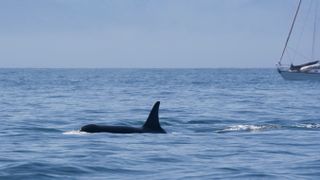
Orcas have attacked and sunk a third boat off the Iberian coast of Europe, and experts now believe the behavior is being copied by the rest of the population.
Three orcas ( Orcinus orca ), also known as killer whales, struck the yacht on the night of May 4 in the Strait of Gibraltar, off the coast of Spain, and pierced the rudder. "There were two smaller and one larger orca," skipper Werner Schaufelberger told the German publication Yacht . "The little ones shook the rudder at the back while the big one repeatedly backed up and rammed the ship with full force from the side."
Schaufelberger said he saw the smaller orcas imitate the larger one. "The two little orcas observed the bigger one's technique and, with a slight run-up, they too slammed into the boat." Spanish coast guards rescued the crew and towed the boat to Barbate, but it sank at the port entrance.
Two days earlier, a pod of six orcas assailed another sailboat navigating the strait. Greg Blackburn, who was aboard the vessel, looked on as a mother orca appeared to teach her calf how to charge into the rudder. "It was definitely some form of education, teaching going on," Blackburn told 9news .
Reports of aggressive encounters with orcas off the Iberian coast began in May 2020 and are becoming more frequent, according to a study published June 2022 in the journal Marine Mammal Science . Assaults seem to be mainly directed at sailing boats and follow a clear pattern, with orcas approaching from the stern to strike the rudder, then losing interest once they have successfully stopped the boat.
"The reports of interactions have been continuous since 2020 in places where orcas are found, either in Galicia or in the Strait," said co-author Alfredo López Fernandez , a biologist at the University of Aveiro in Portugal and representative of the Grupo de Trabajo Orca Atlántica, or Atlantic Orca Working Group.
Related: Grisly new footage shows orcas attacking a great white shark and eating its liver
Sign up for the Live Science daily newsletter now
Get the world’s most fascinating discoveries delivered straight to your inbox.
Most encounters have been harmless, López Fernandez told Live Science in an email. "In more than 500 interaction events recorded since 2020 there are three sunken ships. We estimate that killer whales only touch one ship out of every hundred that sail through a location."
The spike in aggression towards boats is a recent phenomenon, López Fernandez said. Researchers think that a traumatic event may have triggered a change in the behavior of one orca, which the rest of the population has learned to imitate.
"The orcas are doing this on purpose, of course, we don't know the origin or the motivation, but defensive behavior based on trauma, as the origin of all this, gains more strength for us every day," López Fernandez said.
Experts suspect that a female orca they call White Gladis suffered a "critical moment of agony" — a collision with a boat or entrapment during illegal fishing — that flipped a behavioral switch. "That traumatized orca is the one that started this behavior of physical contact with the boat," López Fernandez said.
Orcas are social creatures that can easily learn and reproduce behaviors performed by others, according to the 2022 study. In the majority of reported cases , orcas have made a beeline for a boat's rudder and either bitten, bent or broken it.
"We do not interpret that the orcas are teaching the young, although the behavior has spread to the young vertically, simply by imitation, and later horizontally among them, because they consider it something important in their lives," López Fernandez said.
— 2 orcas slaughter 19 sharks in a single day in South Africa, eating their livers and leaving them to rot
— Orca males are burnouts who let their moms do all the hunting, surprising study finds
— Orcas and humpbacks clash in a violent melee of breaching and biting
Orcas appear to perceive the behavior as advantageous, despite the risk they run by slamming into moving boat structures, López Fernandez added. Since the abnormal interactions began in 2020, four orcas belonging to a subpopulation living in Iberian waters have died, although their deaths cannot be directly linked to encounters with boats.
The unusual behavior could also be playful or what researchers call a "fad" — a behavior initiated by one or two individuals and temporarily picked up by others before it’s abandoned. "They are incredibly curious and playful animals and so this might be more of a play thing as opposed to an aggressive thing," Deborah Giles , an orca researcher at the University of Washington and at the non-profit Wild Orca, told Live Science.
As the number of incidents grows, there is increased concern both for sailors and for the Iberian orca subpopulation, which is listed as critically endangered by the IUCN Red List . The last census, in 2011, recorded just 39 Iberian orcas, according to the 2022 study. "If this situation continues or intensifies, it could become a real concern for the mariners' safety and a conservation issue for this endangered subpopulation of killer whales," the researchers wrote.

Sascha is a U.K.-based trainee staff writer at Live Science. She holds a bachelor’s degree in biology from the University of Southampton in England and a master’s degree in science communication from Imperial College London. Her work has appeared in The Guardian and the health website Zoe. Besides writing, she enjoys playing tennis, bread-making and browsing second-hand shops for hidden gems.
Orca calf refuses to leave a lagoon where its mother stranded and died off Vancouver Island
Brutal footage shows orca mom and son team up to drown another pod's calf
Mpox cases are far outpacing last year's numbers, CDC reports
- ConvictedFelon https://en.m.wikipedia.org/wiki/Porphyrios_(whale) Reply
- Jesus Perhaps it's your exhaust and pollution, and noise. Perhaps frequencies disturb their consciousness. Reply
- slanagat If it were frequencies and exhaust I'd expect them to go after powerboats instead of sailboats. It's intriguing. Reply
- Jesus Perhaps, a neurotoxin. Perhaps, a cry for help. Reply
- schwingingatfences Orca see; orca do. They are intelligent. I'm relieved the focus is how to protect the orca as well as the mariners when the encounters occur. Reply
- puffrfeesh I think the orca can hear the humans interacting in a sail boat they don't like human noises because they aren't the same specie and are foreign to their habitat. Like territorial protection for their water. They are saying we are the largest and most aggressive and we eat white sharks livers just for a snack. Reply
- Nog How about the global warmers are bending the orca's minds with the vibrations from the idiotic windmills. Reply
admin said: Scientists think a traumatized orca initiated the assault on boats after a "critical moment of agony" and that the behavior is spreading among the population through social learning. Orcas have sunk 3 boats in Europe and appear to be teaching others to do the same. But why? : Read more
slanagat said: If it were frequencies and exhaust I'd expect them to go after powerboats instead of sailboats. It's intriguing.
- View All 17 Comments
Most Popular
By Joe Phelan April 01, 2024
By Tom Metcalfe April 01, 2024
By Jamie Carter March 31, 2024
By Orla Loughran Hayes March 31, 2024
By Katherine Irving March 31, 2024
By Melissa Hobson March 30, 2024
By Harry Baker March 30, 2024
By Jennifer Nalewicki March 29, 2024
By Nicoletta Lanese March 29, 2024
- 2 'You could almost see and smell their world': Remnants of 'Britain's Pompeii' reveal details of life in Bronze Age village
- 3 Amazfit Balance review
- 4 Where does the solar system end?
- 5 Polar vortex is 'spinning backwards' above Arctic after major reversal event
- 2 James Webb telescope confirms there is something seriously wrong with our understanding of the universe
- 3 How much does Earth weigh?
- 4 'You probably didn't inherit any DNA from Charlemagne': What it means when your DNA 'matches' a historic person's
May 24, 2023
Why Has a Group of Orcas Suddenly Started Attacking Boats?
Killer whales in a group near Spain and Portugal may be teaching one another to mess with small boats. They sank their third vessel earlier this month
By Stephanie Pappas &
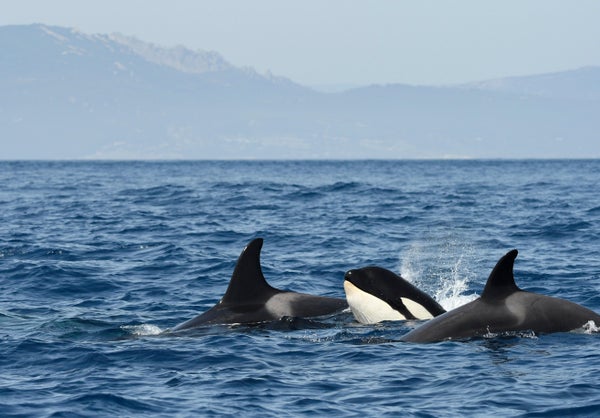
A group of three orcas, also known as killer whales, are seen swimming in the Strait of Gibraltar. Individuals in the critically endangered subpopulation have been attacking boats off the coast of the Iberian Peninsula.
Malcolm Schuyl/Alamy Stock Photo
A trio of orcas attacked a boat in the Strait of Gibraltar earlier this month, damaging it so badly that it sank soon afterward.
The May 4 incident was the third time killer whales ( Orcinus orca ) have sunk a vessel off the coasts of Portugal and Spain in the past three years. The subpopulation of orcas in this region began harassing boats, most often by biting at their rudder, in 2020. Almost 20 percent of these attacks caused enough damage to disable the vessels, says Alfredo López, an orca researcher at the Atlantic Orca Working Group (GTOA), which monitors the Iberian killer whale population. “It is a rare behavior that has only been detected in this part of the world,” he says.
Researchers aren’t sure why the orcas are going after the watercraft. There are two hypotheses, according to López. One is that the killer whales have invented a new fad, something that subpopulations of these members of the dolphin family are known to do. Much as in humans, orca fads are often spearheaded by juveniles, López says. Alternatively, the attacks may be a response to a bad past experience involving a boat.
On supporting science journalism
If you're enjoying this article, consider supporting our award-winning journalism by subscribing . By purchasing a subscription you are helping to ensure the future of impactful stories about the discoveries and ideas shaping our world today.
The first known incident occurred in May 2020 in the Strait of Gibraltar, an area with heavy boat traffic. Since then GTOA has recorded 505 cases of orcas reacting to boats. Sometimes they simply approached the vessels, and only a fraction of cases involved physical contact, López says. In a study published in June 2022 in Marine Mammal Science , he and his colleagues cataloged 49 instances of orca-boat contact in 2020 alone. The vast majority of the attacks were on sailboats or catamarans, with a handful involving fishing boats and motorboats. The average length of the vessels was 12 meters (39 feet). For comparison, a full-grown orca can be 9.2 meters (30 feet) long.
The researchers found that the orcas preferentially attack the boats’ rudder, sometimes scraping the hull with their teeth. Such attacks often snap the rudder, leaving the boat unable to navigate. In three cases, the animals damaged a boat so badly that it sank: In July 2022 they sank a sailboat with five people onboard. In November 2022 they caused a sailboat carrying four to go down. And finally, in this month’s attack, the Swiss sailing yacht Champagne had to be abandoned, and the vessel sank while it was towed to shore. In all cases, the people onboard were rescued safely.
In 2020 researchers observed nine different individual killer whales attacking boats; it’s unclear if others have since joined in. The attacks tended to come from two separate groups: a trio of juveniles occasionally joined by a fourth and a mixed-aged group consisting of an adult female named White Gladis, two of her young offspring and two of her sisters. Because White Gladis was the only adult involved in the initial incidents, the researchers speculate that she may have become entangled in a fishing line at some point, giving her a bad association with boats. Other adult orcas in the region have injuries consistent with boat collisions or entanglement, López says. “All this has to make us reflect on the fact that human activities, even in an indirect way, are at the origin of this behavior,” he says.
The safe rescue of everyone involved, however, suggests to Deborah Giles that these orcas don’t have malevolent motivations against humans. Giles, science and research director of the Washington State–based nonprofit conservation organization Wild Orca, points out that humans relentlessly harassed killer whales off the coasts of Washington and Oregon in the 1960s and 1970s, capturing young orcas and taking them away for display at marine parks. “These are animals that, every single one of them, had been captured at one point or another—most whales multiple times. And these are whales that saw their babies being taken away from them and put on trucks and driven away, never to be seen again,” Giles says. “And yet these whales never attacked boats, never attacked humans.”
Though it’s possible that the orcas around the Iberian Peninsula could be reacting to a bad experience with a boat, Giles says, it’s pure speculation to attribute that motivation to the animals. The behavior does seem to be learned, she says, but could simply be a fad without much rhyme or reason—to the human mind, anyway. Famously, some members of the Southern Resident orcas that cruise Washington’s Puget Sound each summer and fall spent the summer of 1987 wearing dead salmon on their head. There was no apparent reason for salmon hats to come in vogue in orca circles, but the behavior spread and persisted for a few months before disappearing again. “We’re not going to know what’s happening with this population,” Giles says, referring to the Iberian orcas.
The Iberian orca attacks typically last less than 30 minutes, but they can sometimes go on for up to two hours, according to the 2022 study. In the case of the Champagne, two juvenile killer whales went after the rudder while an adult repeatedly rammed the boat, crew members told the German magazine Yacht . The attack lasted 90 minutes.
The Iberian orca subpopulation is considered critically endangered, with only 39 animals the last time a full census was conducted in 2011. A 2014 study found that this subpopulation follows the migration of their key prey , Atlantic bluefin tuna—a route that puts them in close contact with human fishing, military activities and recreational boating. Maritime authorities recommend that boaters in the area slow down and try to stay away from orcas, López says, but there is no guaranteed way to avoid the animals. He and his colleagues fear the boat attacks will come back and bite the orcas, either because boaters will lash out or because the attacks are dangerous to the animals themselves. “They run a great risk of getting hurt,” López says.
Vengeance—or playtime? Why orcas are coordinating attacks against sailboats
The common denominator in dozens of incidents appears to be a mature female named White Gladis.

Orcas, or killer whales , are well known for their intelligence and for their remarkable hunting techniques: whether it’s turning great white sharks upside down or working cooperatively to take down large whales . And a population of orcas off the Iberian Peninsula has been gaining attention over the last three years—and causing angst among sailors—by attacking and even sinking boats in the area.
The first recorded attack occurred in the Strait of Gibraltar in May 2020, with dozens of cases recorded since then. Most of the incidents are remarkably consistent, generally involving a small group of whales attacking the rudders of small sailboats before breaking off and swimming away.
In June and November 2022, a pair of attacks caused two boats to sink; earlier this month, a badly damaged boat sank while it was being towed to shore .
Why the attacks may have started
A recent paper in the journal Marine Mammal Science found that the attacks involved nine whales in two groups: a trio, sometimes a quartet, of juveniles; and a mixed-age group led by a mature female named White Gladis. Given that White Gladis was the only mature female involved, the paper’s authors speculated that she had been involved in an accident with a boat and engaged in retributive behavior, which was then copied by the younger whales.
“When it started happening, I did think that maybe a female or her calf had been nicked by a propeller or rudder on a boat, because every single time they seem to go for the rudder. And it's all on sailboats,” says Dan Olsen, a field biologist with the North Gulf Oceanic Society in Alaska .
However, not everyone is convinced that the orcas’ actions have any malevolent intent. Notably, the orcas’ focus is very specifically on the boats; none have shown any interest in the people on board, even when those people have had to scramble into lifeboats when their vessels started sinking.
"I think it's just as reasonable to suggest that they're doing this because they can, because it's fun,” says Hanne Strager , co-founder of the Andenes Whale Center in Norway and author of the recently published book The Killer Whale Journals .
FREE BONUS ISSUE
A new form of play.
Strager spoke to a biologist who was on board the boat that sunk in November, "and he said, ‘We didn't feel any aggression.’ And, to me, that's actually a strong testimony. Because I think when you are interacting regularly with animals, and you're used to reading them, you can feel an aggressive intent, and they didn't.”
If the orcas are indeed playing, it may suggest that, in time, the boat attacks could end when the whales get bored. Orca populations around the world have been observed engaging in a new behavior for no obvious reason than that they appear to enjoy it and then, just as suddenly, dropping it and moving onto something else. Orca researchers call these play routines “fads.”
Olsen, for example, has observed killer whales off Alaska playing with a piece of kelp for an hour: dragging it around on their fins, dropping it, circling back around and then picking it up in their teeth and swimming around with it some more. Strager has observed similar behaviors in orcas off the coast of Norway.
“For a while we saw them playing around with jellyfish,” she says. “They would swim with them on their snouts and would try to keep them on for as long as possible.”
You May Also Like

Rogue orcas are thriving on the high seas—and they’re eating big whales

Orcas are killing porpoises—but not eating them. Why?

Were you on team orca? Why we wanted nature to 'fight back' in 2023
There's no benefit from this behavior, and the orcas were not eating the jellyfish, Strager notes.
“Sometimes we also see them whack little auks … small Arctic birds, they just lie on the surface of the sea to rest, and the orcas will come and whack them,” which she thinks is also a form of play.
Olsen questions whether we will ever truly understand the motivation behind the behavior, or whether we even really have the capacity to figure it out.
“The whale brain has been evolving separately for 50 million years,” Olsen says. “It’s hard to get a whale into an MRI, we don't even know which parts of the brain are dedicated to which activity. It's hard enough for us to explain behavior in humans and in primates that are closely related to us.”
Facing retaliation
Only this population has shown any interest in attacking boats, and it is a small one: the Marine Mammal Science paper cited an estimate of just 39 individuals.
The population in this region is under threat, says Strager, from tuna fishing, pollution, noise and, indeed, ship strikes.
“They are among the most polluted marine mammals in the world, so their breeding success is not good. It’s a very stressful environment for them,” she says.
And now, added to the existing stressors is the prospect of retaliation.
“Now they are becoming feared in the area,” notes Strager, “and there are reports of people suggesting you should pour diesel on top of them if they attack your boat, that you should put firecrackers in the water or ignite dynamite. I understand if people are afraid. But it's really a very dangerous situation for the killer whales.”
One local group, the Atlantic Orca Working Group , catalogues interactions between whales and boats so that sailors can learn which areas to avoid.
Related Topics
- ORCA (KILLER WHALE)
- ANIMAL WELFARE
Single orca seen killing great white shark for first time ever

Menopause is very rare among animals. Here’s why orcas go through it.

Why are these orcas killing sharks and removing their livers?

You are what you eat—and for orcas, that’s bad news

- History & Culture
- Photography
- Environment
- Paid Content
History & Culture
- History Magazine
- Mind, Body, Wonder
- Terms of Use
- Privacy Policy
- Your US State Privacy Rights
- Children's Online Privacy Policy
- Interest-Based Ads
- About Nielsen Measurement
- Do Not Sell or Share My Personal Information
- Nat Geo Home
- Attend a Live Event
- Book a Trip
- Inspire Your Kids
- Shop Nat Geo
- Visit the D.C. Museum
- Learn About Our Impact
- Support Our Mission
- Advertise With Us
- Customer Service
- Renew Subscription
- Manage Your Subscription
- Work at Nat Geo
- Sign Up for Our Newsletters
- Contribute to Protect the Planet
Copyright © 1996-2015 National Geographic Society Copyright © 2015-2024 National Geographic Partners, LLC. All rights reserved
- Skip to main content
- Keyboard shortcuts for audio player
Revenge of the killer whales? Recent boat attacks might be driven by trauma
Scott Neuman

Killer whales are pictured during a storm in the fjord of Skjervoy in 2021 off the coast of northern Norway. Researchers say orcas are stepping up "attacks" on yachts along Europe's Iberian coast. Olivier Morin/AFP via Getty Images hide caption
Killer whales are pictured during a storm in the fjord of Skjervoy in 2021 off the coast of northern Norway. Researchers say orcas are stepping up "attacks" on yachts along Europe's Iberian coast.
Scientists and sailors say orcas, also known as killer whales, are stepping up "attacks" on yachts along Europe's Iberian coast, with one skipper who's been pursued by the marine mammals on two separate occasions suggesting that their tactics are becoming more stealthy.
Delivery skipper Dan Kriz, who had to be towed into port after orcas destroyed the rudder on a boat he was on in 2020, had an almost identical experience in April.
"My first reaction was, 'Please! Not again,'" Kriz told Newsweek .
Unlike last time, the orcas made a stealthier approach without the characteristic squeaks they normally use to communicate, he says. They made quick work of the two rudders on the catamaran Kriz was delivering. "Looks like they knew exactly what they are doing. They didn't touch anything else," he said.
View this post on Instagram A post shared by Catamaran Guru (@catamaranguru)
Most marine scientists have characterized hundreds of encounters between boats and orcas that have sunk at least three vessels and damaged dozens of others over the years as a "fad," implying that the animals will eventually lose interest and resort to more typical behavior.

Killer whales are 'attacking' sailboats near Europe's coast. Scientists don't know why
But if that's the case, there are few signs this behavior is going out of style anytime soon. According to a June 2022 study published in the journal Marine Mammal Science , orcas have stepped up the frequency of their interactions with sailing vessels in and around the Strait of Gibraltar, the busy waterway that links the Mediterranean Sea with the Atlantic Ocean.
Some researchers think it's merely playful behavior
As NPR first reported last August, many scientists who study orca behavior believe these incidents — in which often one or more of the marine mammals knock off large chunks of a sailboat's rudder — are not meant as attacks, but merely represent playful behavior.
One hypothesis put forward by Renaud de Stephanis, president and coordinator at CIRCE Conservación Information and Research, a research group based in Spain, is that orcas like the feel of a boat's rudder.
"What we think is that they're asking to have the propeller in the face," de Stephanis told NPR last year. "So, when they encounter a sailboat that isn't running its engine, they get kind of frustrated and that's why they break the rudder."

A picture taken on May 31 shows the rudder of a vessel damaged by killer whales ( Orcinus orca ) while sailing in the Strait of Gibraltar and taken for repairs at the Pecci Shipyards in Barbate, near Cadiz, southern Spain. Jorge Guerrero/AFP via Getty Images hide caption
A picture taken on May 31 shows the rudder of a vessel damaged by killer whales ( Orcinus orca ) while sailing in the Strait of Gibraltar and taken for repairs at the Pecci Shipyards in Barbate, near Cadiz, southern Spain.
In another recent encounter, Werner Schaufelberger told the German publication Yacht that his vessel, Champagne, was approached by "two smaller and one larger orca" off Gibraltar.
"The little ones shook the rudder at the back while the big one repeatedly backed up and rammed the ship with full force from the side," he said.
The Spanish coast guard rescued Schaufelberger and his crew, towing Champagne to the Spanish port of Barbate, but the vessel sank before reaching safety.
The encounters could be a response to past trauma
Since 2020, there have been more than 500 encounters between yachts and orcas in the area, according to one of the study's co-authors, Alfredo López Fernandez, a biologist at the University of Aveiro in Portugal and a representative of the Grupo de Trabajo Orca Atlántica , or Atlantic Orca Working Group.
López Fernandez believes that a female known as White Gladis, who leads the group of around 40 animals, may have had a traumatizing encounter with a boat or a fishing net. In an act of revenge, she is teaching her pod-mates how to carry out revenge attacks with her encouragement, researchers believe.

A worker cleans Champagne, a vessel that sank after an attack by orcas in the Strait of Gibraltar and was taken for repairs at the Pecci Shipyards in Barbate, near Cadiz, southern Spain, on May 31. Jorge Guerrero/AFP via Getty Images hide caption
A worker cleans Champagne, a vessel that sank after an attack by orcas in the Strait of Gibraltar and was taken for repairs at the Pecci Shipyards in Barbate, near Cadiz, southern Spain, on May 31.
"The orcas are doing this on purpose, of course, we don't know the origin or the motivation, but defensive behavior based on trauma, as the origin of all this, gains more strength for us every day," López Fernandez told Live Science .
It's an intriguing possibility, says Monika Wieland Shields, director of the Orca Behavior Institute .
"I definitely think orcas are capable of complex emotions like revenge," she says. "I don't think we can completely rule it out."
However, Shields is not ready to sign on to the "revenge" hypothesis just yet. She says that despite humans having "given a lot of opportunities for orcas to respond to us in an aggressive manner," there are no other examples of them doing so.
Deborah Giles, the science and research director at Wild Orca, a conservation group based in Washington state, is also skeptical of the hypothesis. She points out that killer whale populations in waters off Washington "were highly targeted" in the past as a source for aquariums. She says seal bombs, small charges that fishers throw into the water in an effort to scare sea lions away from their nets, were dropped in their path while helicopters and boats herded them into coves.
"The pod never attacked boats after that," she says. "It just doesn't ring true to me."
Shields says it's important to remember that whatever the motive is for the behavior of the orcas off the Iberian coast, it isn't being transmitted to pods in other parts of the world.
"We've had folks here in Washington [asking] 'is it safe to go out in the water here with these orcas?'" she says. "While this is kind of an ongoing situation in that specific place, I don't think there's any reason to think it's going to start spreading to other populations of orcas."
Advertisement
Why have orcas been damaging and sinking so many boats?
Orcas have been documented damaging or sinking boats off the coast of Spain and Portugal, but these altercations may simply be the whales scratching their backs on boats or playing terrifying games
By Corryn Wetzel
20 June 2023

Orcas swimming in the wake of a boat off the coast of Spain
Government of Spain - Ministry of Transport, Mobility and Urban Agenda
In the past few months, there have been several reports of orcas severely damaging sailing boats off the coast of Spain and Portugal. At least a dozen whales are taking part in the activity, sparking a flurry of speculation over whether the orcas ( Orcinus orca ) may be teaching each other how to bring down boats and organising into an army. But there are non-combative reasons that could be behind the rise in encounters.
Where is this happening?
In the Strait of Gibraltar, there is a pod of orcas that have been ramming boats and ripping off the rudders, sinking three sailboats and damaging dozens more over the past year. The orcas began a new wave of activity this May, and videos documenting the encounters have been sweeping the internet since.

How long has this been going on?
People have been paying more attention recently, but altercations with these orcas have been reported for years . Scientists, fishermen and locals began reporting unusual encounters in the Strait of Gibraltar in May 2020 . According to the Atlantic Orca Working Group , which tracks this pod, there were 207 reported interactions in 2022, and at least 20 last month alone. While many interactions were relatively harmless, at least three ships have sunk this year, with no reported injuries to people.
Over the past few years, these orca-boat confrontations in the Mediterranean seem to have escalated during the month of May when the pod’s favourite food, bluefin tuna, is migrating through the area.
Orca seen foster parenting a pilot whale calf for first time
What exactly are the orcas doing to boats?
In most encounters, orcas quickly approach the stern of the boat, with an apparent interest in the boat’s rudders, which they pierce or snap with their teeth. The whales have also been seen pressing into sailboats with their head and the flank of their body, occasionally tearing holes in the hull. Sometimes, they cause no damage to the ships, instead riding in the boat’s wake. Notably, this group of whales seems less interested in large or motorised vessels. “They’re hyper-focused on sailboats,” says Deborah Giles at the University of Washington in Seattle.
Sign up to our Wild Wild Life newsletter
A monthly celebration of the biodiversity of our planet’s animals, plants and other organisms.
How many orcas are involved?
Each encounter usually involves only a handful of whales from a pod of around 39 total orcas. Images and video of the events are helping researchers track which individuals are most involved and which have yet to exhibit the behaviour. Currently, around 15 orcas are partaking in the boat-ramming activity. “It’s a behaviour that has probably spread from one individual,” says Andrew Trites at the University of British Columbia in Canada.
Can orcas learn from one another? Will this behaviour spread?
Orcas are a social species capable of learning from their podmates, so it is possible the behaviour is a trend that is catching on. But that doesn’t mean that the whales are intentionally teaching their podmates to target boats, which would require communicating a motive and recruiting others to the cause. Instead, it may just look fun or interesting to the orcas.
This North Atlantic subpopulation, like many orca pods, is distinct from others in diet , culture , dialect and genetics. These orcas don’t mingle with those outside their pod, so it is unlikely this behaviour will spread to other populations of orcas, though it could spread through some of the rest of their pod.
Orcas are spreading further into the Arctic Ocean as sea ice melts
Why are orcas doing this? Is it revenge?
Online rumours have swirled about an orca called White Gladis, who was supposedly traumatised in an encounter with a boat – this is speculation based on healed injuries on her fins, but these haven’t been confirmed to be from a boat. Orcas rake each other with their teeth, which could be the source of the scars. But most experts agree there isn’t any evidence White Gladis is training other whales to attack, and no clear motive for podmates to risk personal injury for her vengeance.
“Nobody knows why this is happening,” says Trites. “All the reports coming in have been from non-scientists, non-specialists – people that are terrified.” He says orcas are a highly intelligent species capable of self-recognition, but that doesn’t necessarily mean they are capable of planning and enacting revenge.
What else could be behind the increase in orca encounters?
Both Trites and Giles think it is more likely that the orcas are just having fun or seeking an admittedly terrifying back scratch. “These whales are very tactile,” says Giles. “They interact with things in their environment, including each other.” A pod of whales in British Columbia has been seen vigorously rubbing against rocky beaches, for example.
Wild orcas have never been documented hunting or eating humans, so it is unlikely this relates to wanting a meal.
Until researchers know what is motivating the encounters, it will be challenging to abate them. If the orcas see the activity as a game, for example, fleeing may elicit a more aggressive response. “This is something that we humans need to figure out and not place the blame on the whales,” says Giles.
- endangered species /
- whales and dolphins /
- marine life
Sign up to our weekly newsletter
Receive a weekly dose of discovery in your inbox! We'll also keep you up to date with New Scientist events and special offers.
More from New Scientist
Explore the latest news, articles and features
Blue tits shared a tree hollow with bird-eating bats – and survived
Subscriber-only
Extinct freshwater dolphin from the Amazon was largest of all time
Incredible picture of polar bear snoozing atop an iceberg is a winner, environment, what a trip to far-flung islands taught me about protecting our oceans, popular articles.
Trending New Scientist articles
Orcas sink another boat in Strait of Gibraltar off Morocco
For years, the region’s killer whales have been bumping, biting and, in some cases, sinking boats. but many scientists caution not to ascribe motive to the animals..

The orcas have done it again.
On Oct. 31, a pod of killer whales swarmed a Polish yacht sailing in the Strait of Gibraltar. For 45 minutes, the orcas hit the vessel’s rudder and damaged the boat, according to the company that operated it. Despite rescue efforts, the yacht never made it back to shore, sinking near the entrance of the Moroccan port of Tanger Med.
“The crew is safe, unharmed and sound,” the Polish tour company Morskie Mile wrote in a Facebook post describing the demise of its boat.
Since 2020, orcas in the Strait of Gibraltar and along the Iberian Peninsula have been bumping and biting boats — oftentimes, yachts — in dozens of incidents that have frightened mariners and confounded scientists.
A recent spate of killer whales sinking boats delighted online observers who anthropomorphize the marine mammals and hail them as working-class heroes.
Are the orcas really out to get us? What to know about recent attacks.
Fishing vessels and motorboats have all had their run-ins with orcas in the region, though sailboats appear to be the most popular target, according to a 2022 study . The tour agency Morskie Mile did not immediately reply to a request for comment.
No one is quite sure what is prompting the orcas to go after vessels — whether the whales are simply being playful, or had a bad run-in with a boat in the past, prompting the aggressive behavior.
Some scientists say the incidents should not be called “attacks” at all, since the whale’s motives are unknown. Perpetuating the idea that whales are out for revenge, they fear, may lead to retaliation by boaters.
“We urge the media and public to avoid projecting narratives onto these animals,” a group of more than 30 scientists wrote in an open letter this summer. “In the absence of further evidence, people should not assume they understand the animals’ motivations.”
What we do know is that orcas are highly intelligent marine mammals that appear to learn from one another. Usually, that learned behavior is a hunting strategy, such as corralling and eating massive blue whales .
Other times, it is something stranger, such as when orcas near Seattle were observed “wearing” dead salmon as hats. Orcas, it turns out, can be victims of cultural fads, too.
One other thing is clear: Killer whales normally don’t hurt people. And humans are a bigger threat to them than they are to us.
Getting entangled in fishing gear or struck by speeding boats is a threat for all whales. With perhaps fewer than 40 individuals left , the orca population off the coasts of Spain, Portugal and Morocco is considered critically endangered by the International Union for Conservation of Nature.

Things you buy through our links may earn Vox Media a commission.
Why Do Orcas Keep Messing With Boats in Southern Europe?

On Thursday morning, a small group of killer whales battered the 66-foot sailing yacht Mustique off the coast of southern Spain, doing enough damage — including puncturing the hull and breaking the rudder — that the crew had to call in a maritime rescue and the vessel had to be towed to port for repairs. It was the second time in less than a week that such an encounter was reported in the area, and the latest in a baffling series of seeming attacks on boats by the animals in or near the Strait of Gibraltar. On May 5, the 50-foot sailing yacht Alboran Champagne sank after being struck by orcas the previous night — the third vessel in the last three years to go under after a run-in with some unruly Orcinus orca locals.
It’s still not clear why these highly intelligent, innately curious mammals — who have apparently been learning the behavior from each other — are going after the boats or whether the damage is even intentional. Some scientists have theorized that the behavior may be a kind of self-defense that originated with a single female orca after a traumatic encounter with a boat. It’s also possible it’s just a fad that has become popular with some of the orcas and will eventually fall out of fashion — a phenomenon scientists have previously observed among orcas and other members of the dolphin family.
Since the first known incident in May 2020, Grupo Trabajo Orca Atlántica (the Atlantic Orca Working Group) has tracked more than 500 cases in which members of the Iberian orca population reacted to or harassed boats in some way. But only a very small percentage of these encounters have involved physical contact, and only a handful of animals in this small endangered population of orcas appear to have engaged in the abnormal behavior — many of them juveniles. When the encounters have turned physical, the orcas have typically targeted the boats’ rudders and have sometimes bumped or rammed the boats themselves. In those instances, less than 20 percent of the vessels have been disabled as a result; and everyone aboard was safely rescued afterward.
These animals are not acting like horror-movie monsters, in other words, nor is their abnormal behavior deserving of some of the sensational news coverage the incidents have received in recent weeks. At the same time, the alarming encounters have become a routine hazard for people who sail in the area, some of whom have been using a Facebook group called Orca Attack Reports and other online forums to share experiences and advice on how to avoid or limit close encounters with the mammals.
GTOA scientists believe just 15 individual orcas out of a population of more than 50 in the area are taking part in the incidents, and that the behavior may be something invented out of the blue by the animals or might be a kind of reaction to previous encounters with vessels. Scientific American reports :
In a study published in June 2022 in Marine Mammal Science , [GTOA researcher Alfredo López] and his colleagues cataloged 49 instances of orca-boat contact in 2020 alone. The vast majority of the attacks were on sailboats or catamarans, with a handful involving fishing boats and motorboats. The average length of the vessels was 12 meters (39 feet). For comparison, a full-grown orca can be 9.2 meters (30 feet) long … In 2020 researchers observed nine different individual killer whales attacking boats[.] The attacks tended to come from two separate groups: a trio of juveniles occasionally joined by a fourth and a mixed-aged group consisting of an adult female named White Gladis, two of her young offspring and two of her sisters. Because White Gladis was the only adult involved in the initial incidents, the researchers speculate that she may have become entangled in a fishing line at some point, giving her a bad association with boats. Other adult orcas in the region have injuries consistent with boat collisions or entanglement, López says. “All this has to make us reflect on the fact that human activities, even in an indirect way, are at the origin of this behavior,” he says.
Other scientists are skeptical that a traumatic experience prompted the behavior. Orca expert Erich Hoyt told the New York Times that it was likely the animals involved in the incidents are “getting some sort of reward or thrill from it,” since “play is part of being a predator.”
Another marine mammal expert, University of St. Andrews’s Luke Rendell, notes at the Conversation that the past-trauma theory is plausible but unlikely to be something anyone will ever be able to prove:
Notions of collective self-defence in cetaceans (aquatic mammals including whales, dolphins and porpoises) are far from outlandish. We have accounts of sperm whales rising to each other’s defence when orcas attack, for example. Solidarity is a more subjective issue, and we don’t have access to the internal mental states of these animals to really understand whether this is going on … It is not impossible that these orcas perceive their own common aggressor in us — but it is also entirely possible they have no such concept.
Orca Behavior Institute director Monika Wieland Shields explained to NBC News that appearances can also be deceiving. “I think it gets taken as aggression because it’s causing damage, but I don’t think we can say that the motivation is aggressive necessarily,” she said, adding that there is no evidence of orcas seeking payback on humans:
We know their brains are wired to have really complex emotions, and so I think they could be capable of something like anger or revenge. But again, it’s just not something that we’ve seen any examples of, and we’ve given them plenty of opportunities throughout the world to want to take revenge on us for various things. And they just choose not to.
In addition, scientists are worried the population of Iberian orcas, which is already critically endangered, will face retaliation from humans over the incidents, as Andenes Whale Center co-founder Hanne Strager emphasized in an interview with National Geographic :
They are among the most polluted marine mammals in the world, so their breeding success is not good. It’s a very stressful environment for them. … Now they are becoming feared in the area, and there are reports of people suggesting you should pour diesel on top of them if they attack your boat, that you should put firecrackers in the water or ignite dynamite. I understand if people are afraid. But it’s really a very dangerous situation for the killer whales.
This post has been updated.
- animal behavior
- weird science
- the environment
Most Viewed Stories
- The Boeing Nosedive
- Andrew Huberman’s Mechanisms of Control
- What to Know About the Latest Student-Loan Forgiveness Plans
- Antony Blinken Stranded by Boeing Again
- What Led a New York Midwife to Fake 12,499 Vaccine Records?
- Elon Musk’s Tesla Empire Is Facing ‘Unmitigated Disaster’
Editor’s Picks

Most Popular
- The Boeing Nosedive By Jeff Wise
- Andrew Huberman’s Mechanisms of Control By Kerry Howley
- What to Know About the Latest Student-Loan Forgiveness Plans By Lynnley Browning
- Antony Blinken Stranded by Boeing Again By Matt Stieb
- What Led a New York Midwife to Fake 12,499 Vaccine Records? By James D. Walsh
- Elon Musk’s Tesla Empire Is Facing ‘Unmitigated Disaster’ By Kevin T. Dugan

What is your email?
This email will be used to sign into all New York sites. By submitting your email, you agree to our Terms and Privacy Policy and to receive email correspondence from us.
Sign In To Continue Reading
Create your free account.
Password must be at least 8 characters and contain:
- Lower case letters (a-z)
- Upper case letters (A-Z)
- Numbers (0-9)
- Special Characters (!@#$%^&*)
As part of your account, you’ll receive occasional updates and offers from New York , which you can opt out of anytime.
- Share full article
Advertisement
Supported by
‘Everybody Is a Bit on Edge’: Sailors Trade Tips on Steering Clear of Orcas
With a pod of the sea creatures ramming boats in the Strait of Gibraltar, some crews are turning to homegrown solutions. Can playing heavy metal really keep them away?

By Isabella Kwai
The first time orcas appeared near his catamaran, Florian Rutsch was surprised, but prepared.
Like many venturing around the Iberian Peninsula, Mr. Rutsch had browsed Facebook groups, Telegram chats and other online platforms where sailors have been swapping tips on a relatively recent phenomenon: How do you get orcas to leave your boat alone?
In May, when the crew of his catamaran, which he charters for high-end voyages and retreats, encountered an orca group while crossing the Strait of Gibraltar, he tried some of those ideas. He scattered sand in the water, which some sailors thought could act as a deterrent (unsubstantiated). Then he slammed the engine into full throttle, moving away from the group (advice supported by the Spanish government ).
The orcas left them alone. But his second encounter with the animals in November was less civil.
This time, to deter them, the crew also tried another idea that had been passed along: booming a curated playlist of heavy metal — titled “Metal for Orcas” — through an underwater speaker. But the animals had moved quickly, targeting the rudder and disabling the boat’s steering. The crew had to call for help, and eventually Spanish rescue authorities arrived and towed the vessel to port.

“It is scary,” said Mr. Rutsch. “No one knows what works, what doesn’t work.”
‘It’s the talk of the town.’
Since 2020, orcas — apex predators that are the largest members of the dolphin family — have been disrupting the journeys of boats along the coastlines of the Iberian Peninsula, causing enough damage to a handful to sink them . Researchers don’t know why.
Online, some have been charmed by the schadenfreude of the orcas striking back at their yacht overlords, but biologists say it’s likely that the curious animals have simply learned a new way to play with boats.
It is less charming for the skippers and boat owners navigating some of the busiest water lanes in the world in floating homes that can be costly to repair. A small percentage of sailing boats have been affected, according to researchers, who are still testing methods that could minimize the interactions.
But until a tried-and-tested solution is found, sailors are gathering, online and in person, to compare notes. One Facebook group , with 59,000 members, details accounts of interactions, while in another, users talk tactics . In Telegram chats, they ask for feedback on detours to avoid what has been called “orca alley.”
“People are more informed,” said Rui Alves, a former sailor who founded Orcas.pt to help sailors connect and discuss the issue. Mr. Alves says he has been surprised at the site’s popularity — when he started it in October 2022, about 10 people joined. Now, there are almost 2,000.
“We have the local sailors, Portuguese and Spanish, and we have these sailors coming from the U.K. to cross the Atlantic,” he said.
More established groups like the Cruising Association, a Britain-based group for sailors, have also been tracking accounts from crews and collaborating with researchers to offer up-to-date information . “Sailors working together with appropriate scientists is the best approach to finding a solution,” Paul Lingard, a spokesman for the group, said in a statement.
“It’s the talk of the town in the sailing community,” said Emma Gore, a yacht sailor who found advice from Facebook groups helpful when she encountered an orca off the coast of Morocco. “Everybody is a bit on edge.”

Sail away, sail away, sail away.
Do any of the deterrents posed by sailors work? Researchers are skeptical that scattering sand or changing the color of a boat’s hull (avoiding black is one suggestion) do much. They also caution that some of the suggested methods — like throwing firecrackers into the water or using pingers, devices that transmit high-pitched signals underwater — could hurt the animals, which are considered endangered.
There are plans, according to the Cruising Association, to test out an acoustic device that could deter orcas from approaching without causing harm to them. And biologists are tracking the animals , some working with the Spanish government to understand how adjusting boat movements could minimize the chance of interactions.
For now, researchers and authorities say, the only real solution is to sail in shallower waters and move away as fast as possible during an orca encounter.
“The solution is to leave the area,” said Renaud de Stephanis, a biologist and coordinator for the nonprofit research group CIRCE. He’s part of a project that is satellite-tagging orcas to better track their movements as they chase tuna along the coastline. Mr. de Stephanis said it was clear that the orcas had learned how to break rudders, and research this year suggested that not stopping a boat could minimize the animals’ opportunities to do so.
Mr. Alves, the Orcas.pt founder, said, “I think long term it will be that we know where they are — and we avoid that area.” Many sailors are already taking that advice to heart and say they will stop sailing through any orca lanes until a solution is found.
“I do worry that people will resort to more drastic measures if we don’t find harmless solutions soon,” said Mr. Rutsch, the German sailor. Detours to avoid the orcas could add days, or even weeks, to a journey, and shallow waters open boats up to other dangers like underwater rocks and fishing nets.
“No sailor really wants to hurt any orcas,” Mr. Rutsch added. “That is the big conundrum here.”
He was tense during a crossing of the Strait of Gibraltar last week, he said, and took a flare and a foghorn in case of another encounter.
“Luckily this time,” he said. “We were only briefly scared by some dolphins.”
Isabella Kwai is a breaking news reporter in the London bureau. She joined The Times in 2017 as part of the Australia bureau. More about Isabella Kwai
Morning Rundown: Israel halts military leave after Iran threats, Trump special counsel rips judge request, and why Germany is being threatened with elephants
Orcas’ latest boat attack claims yacht sailing in Strait of Gibraltar
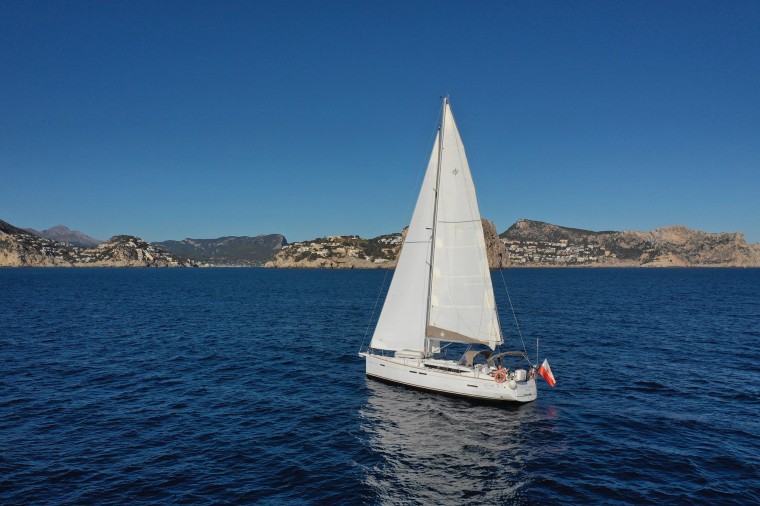
A yacht sank after it was attacked by a pod of orcas for 45 minutes, a sailing company has said, marking the latest assault on a boat by the sea mammals this year.
Polish tour operator Morskie Mile — which means "sea miles" — said in a Facebook post that its yacht Grazie Mamma II was attacked while sailing the Strait of Gibraltar between Spain and Morocco on Oct. 31.
The whales attacked the boat's rudder, the company said, causing major damage and a leak. Despite an attempt by the captain to take the boat to the nearest port, and a rescue attempt that involved the Moroccan Navy, the yacht sank near the entrance to the port of Tanger Med, about an hour's drive east of the city of Tangiers.
The boat's crew were unharmed, the company said in a statement that NBC News translated from Polish. The same statement was posted to the company's website by company owner Lech Lewandowski.
"For us, this yacht was everything that was great about sea sailing," he said.
"Long-term friendships were formed onboard. We sailed this yacht through the most beautiful places in Europe and the Atlantic archipelagos, trained numerous yacht helmsmen, discovered the beautiful and unknown, tasted Mediterranean specialties and sailed, sailed, sailed," Lewandowski continued.
The company said it was planning to honor forthcoming cruise bookings by using "friends' yachts." Future trips will take in the Baltic Sea, Norway, Italy and the Canary Islands, according to the company's website. A single leg of a voyage can cost 1,800 Polish zloty ($432).
In May, it emerged that orcas were responsible for attacking and sinking three boats in southern Europe. Encounters between orcas and humans have been increasing since 2020, researchers say , but no human deaths have been reported.
The increased orca-boat activity has led to a slew of internet memes this year, with some claiming they were joining the "orca wars" on the side of the orcas.
In September, a Russian boat on a round-the-world trip was sunk after a prolonged attack by tiny cookiecutter sharks.
Patrick Smith is a London-based editor and reporter for NBC News Digital.

Boaters capture pulse-pounding video of orcas battling sperm whales
A group of tourists in Australia have captured rare footage of two "titans of the sea" clashing against each other. The video showcases how a pod of orcas chases down and attacks a group of sperm whales. It's something we don't see happen often, and it builds on strange orca attacks that have been happening over the past several months.
Previously, we'd even see orcas attacking boats off the coast, something that has sparked some serious questions about the state of this particular whale's habitat. What's even more intriguing is that one particular orca appeared to be teaching others to do the same thing. You can see a video of one of the previous attacks in the footage below.
Now, with this latest video, it seems that the orcas have turned their violent tendencies toward another ocean creature. The video, which was shared on Naturaliste Charters' Facebook, showcases the pod of orcas hovering around the group of sperm whales after chasing them into shallow waters. This orca attack was unexpected, the tourist company says.
Writing in a post on Facebook, the company says that many of them assumed that the prey the orcas were chasing was likely a beaked whale, as those are often on the menu for Bremer orcas like those captured in the video. However, as they drew closer to the orca's attack, they realized the group was actually made up of several sperm whales, including one smaller one believed to be a juvenile.
As the fight escalated, the company says that they saw a dark bubble of reddish brown appear in the water, and then one of the orcas rose up out of the water with a chunk of meat in its jaws. Soon after, the orcas called off their attack and retreated.
Fortunately, the company says it does not believe that any of the sperm whales were actually taken down. Instead, they believe the chunk of meat may have been a squid or something else taken from the sperm whales, possibly even regurgitated to help drive off the orcas.
As for the dark bubble, they now believe it was likely feces, as sperm whales have been known to release their bowels in attempts to drive off predators. In this case, it seems to have worked.
The post Boaters capture pulse-pounding video of orcas battling sperm whales appeared first on BGR .

BETA GIDA, OOO
- / BUSINESS DIRECTORY
- / MANUFACTURING
- / FOOD MANUFACTURING
- / OTHER FOOD MANUFACTURING
- / RUSSIAN FEDERATION
- / MOSCOW REGION
- / ELEKTROSTAL
- / BETA GIDA, OOO
- Ozench Avdzhy Director-General
Dynamic search and list-building capabilities
Real-time trigger alerts
Comprehensive company profiles
Valuable research and technology reports
Norilsk: The city built by gulag prisoners where Russia guards its Arctic secrets
Environmental activists are frustrated by how authorities handled a diesel spill which poured into two Arctic rivers in late May.

International correspondent @DiMagnaySky
Friday 3 July 2020 23:41, UK
Please use Chrome browser for a more accessible video player

The drive from Norilsk airport to the city takes you past mile after mile of crumbling, Soviet-era factories.
It looks like an endless, rusting scrapyard - a jumble of pipes, industrial junk and frost-bitten brickwork. If you were looking for an industrial apocalypse film setting, this would be your place - but you're unlikely to get the permissions.
Norilsk was built in Stalin's times by gulag prisoners. This gritty industrial city is a testament to their endurance both of the cruelty of Stalin's regime and of the harsh polar climate. There were no thoughts then on how to build to protect the environment, just to survive it.
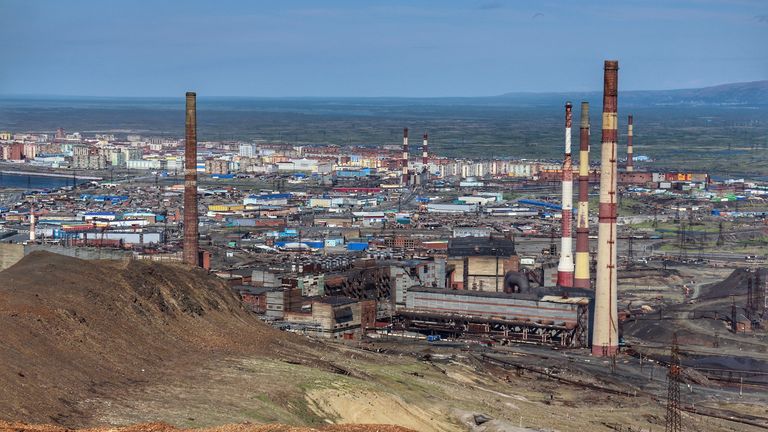
Vasily Ryabinin doesn't think much has changed, at least in ecological terms. He used to work for the local branch of the federal environmental watchdog, Rosprirodnadzor, but quit in June after exposing what he says was a failure to investigate properly the environmental impact of the gigantic diesel spill which poured into two Arctic rivers in late May.
At 21,000 tonnes, it was the largest industrial spill in the polar Arctic .
Despite the Kremlin declaring a federal emergency and sending a host of different agencies to participate in the clean-up, just last week Mr Ryabinin and activists from Greenpeace Russia found another area where technical water used in industrial processes was being pumped directly into the tundra from a nearby tailing pond. Russia's investigative committee has promised to investigate.
"The ecological situation here is so bad," Mr Ryabinin says.
"The latest constructions such as the tailing pond at the Talnack ore-processing plant were built exclusively by Nornickel chief executive Vladimir Potanin's team and supposedly in accordance with ecological standards, but on satellite images you can see that all the lakes in the vicinity have unnatural colours and obviously something has got into them."

Mining company Nornickel would disagree. It has admitted flagrant violations at the tailing pond and suspended staff it deems responsible at both the Talnack plant and at Norilsk Heat and Power plant no 3 where the diesel spill originated from.
On Thursday it appointed Andrey Bougrov, from its senior management board, to the newly-created role of senior vice president for environmental protection. It has a clear environmental strategy, provides regular updates on the status of the spill, and its Twitter feed is filled with climate-related alerts.
But what investors read is very different to the picture on the ground.

Norilsk used to be a closed city - one of dozens across the Soviet Union shut off to protect industrial secrets. Foreigners need special permissions approved by the Federal Security Service (FSB) to enter the region. It would take an invitation from Nornickel to make that happen and, for the past month since the spill, that has not been forthcoming.
Unlike in Soviet times, Russian citizens are now free to come and go. That's why our Sky News Moscow team were able to fly in and travel around the city, even if getting to the spill site was blocked. What they were able to film provides a snapshot of the immense challenge Russia faces in upgrading its Soviet-era industrial infrastructure, particularly at a time when climate change is melting the permafrost on which much of it was built.

Just downwind from one of the rusting factories on the city outskirts is a huge expanse of dead land. The skeletal remains of trees stand forlorn against the howling Arctic winds. Sulphur dioxide poisoning has snuffed the life out of all that lived here. Norilsk is the world's worst emitter of sulphur dioxide by a substantial margin.
"For 80km south of here everything is dead," Mr Ryabinin says, "and for at least 10km in that direction too. Everything here depends on the wind."
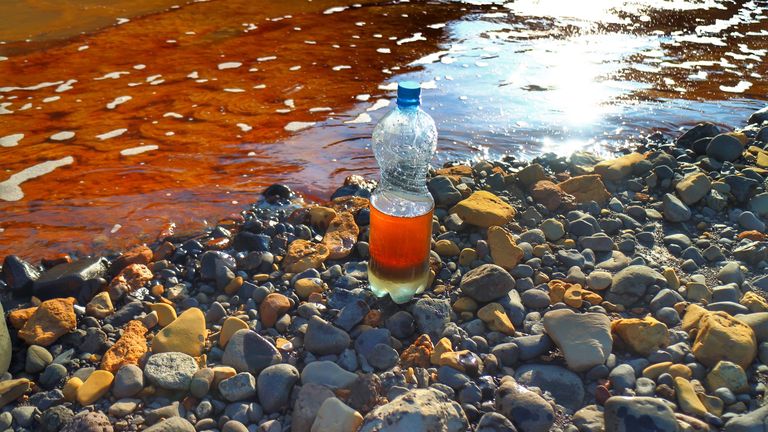
Immediately after the spill, Mr Ryabinin filmed and took samples from the Daldykan river just a few kilometres from the fuel tank which had leaked. By that point the river was a churning mix of diesel and red sludge dredged up from the riverbed by the force of the leak. Norilsk's rivers have turned red before and the chemical residues have sunk to the bottom, killing all life there. Nothing has lived in those rivers for decades.
In his capacity as deputy head of the local environmental watchdog, Mr Ryabinin says he insisted that he be allowed to fly further north to check the levels of contamination in Lake Pyasino and beyond.
Nornickel at the time claimed the lake was untouched by the spill. Mr Ryabinin says his boss encouraged him to let things be.
"I can't be sure I would have found anything, but this sort of confrontation - making sure I didn't go there with a camera, let alone with bottles for taking samples, it was all very clear to me. It was the final straw."
Rosprirodnadzor refused to comment to Sky News on Mr Ryabinin's allegations or suggestions that the agency was working hand in hand with Nornickel.
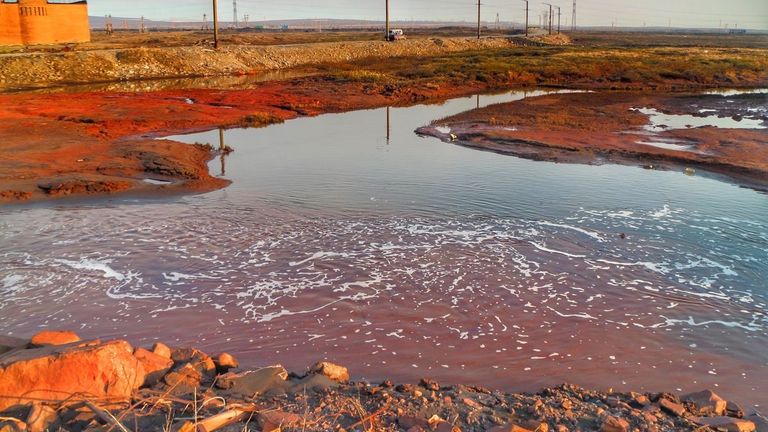
Georgy Kavanosyan is an environmental blogger with a healthy 37,000 following on YouTube. Shortly after the spill, he set out for Lake Pyasino and to the Pyasina River beyond to see how far the diesel had spread.
"We set out at night so that the Norilsk Nickel security wouldn't detect us. I say at night, but they've got polar nights there now, north of the Arctic Circle. So it's still light but it's quieter and we managed to go past all the cordons."
He is one of the few to have provided evidence that the diesel has in fact travelled far beyond where the company admits. Not just the 1,200km (745m) length of Lake Pyasino but into the river beyond.
He says his measurements indicated a volume of hydrocarbons dissolved in the water of between two and three times normal levels. He thinks after he published his findings on YouTube, the authorities' vigilance increased.
Greenpeace Russia have spent the last two weeks trying to obtain samples from Lake Pyasino and the surrounding area. They have faced difficulties getting around and flying their samples out for independent analysis.
They are now waiting for results from a laboratory in St Petersburg but say the samples remain valid technically for just four days after collection and that they weren't able to make that deadline due to the authorities' actively obstructing their work.

Elena Sakirko from Greenpeace Russia specialises in oil spills and says this has happened to her before. This time, a police helicopter flew to the hunter's hut where they were staying and confiscated the fuel for the boat they were using. Then a deputy for the Moscow city parliament tasked with bringing the samples back from Norilsk was forced to go back empty-handed.
"We were told at the airport we needed permission from the security department of Nornickel," Ms Sakirko says. "We asked them to show us some law or statement to prove that this was legal or what the basis for this was, but they haven't showed us anything and we still don't understand it."
Nornickel announced this week that the critical stage of the diesel spill is over. The company is now finalising dates for a press tour for foreign media and for other international environmentalists.
Mr Ryabinin thinks this should have happened weeks ago.
"If we don't let scientists come to the Arctic region to evaluate the impact of the accident, then in the future if anything similar happens, we won't know what to do."
A spokesperson for Nornickel said the company "is actively cooperating with the scientific community and will meticulously assess both the causes and effects of the accident."
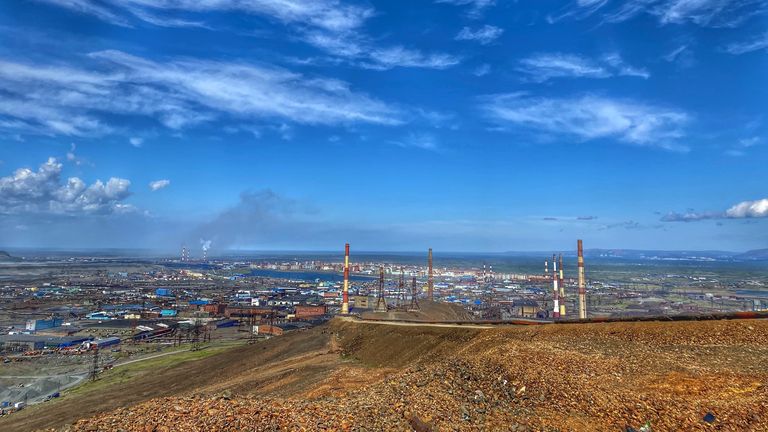
Nornickel considers permafrost thawing to be the primary cause of the accident, but is waiting for the end of investigation before making a final statement, the spokesperson said.
They added that the company "accepts full responsibility for the incidents on its sites these past two months and holds itself accountable for any infrastructural deficits or poor decisions by personnel.
"The imperative is to do everything to clean up our sites, instil a stronger culture of transparency and safety in our workforce, and ensure that such situations do not occur in the future."
Residents Outside Moscow Protest Power Outage, Demand Heating Amid Subzero Temperatures

Residents of a Moscow region town impacted by power outages have taken to the streets, demanding that local authorities restore heat to their homes as subzero temperatures grip the region, Russian media reported Friday.
At least 21,000 people had power knocked out in their homes on Thursday morning in the town of Podolsk when a heating main burst at the Klimovsk Specialized Ammunition Plant, according to the Kommersant business daily.
The circumstances surrounding the incident at the plant in Podolsk, located some 50 kilometers south of Moscow, have not been disclosed.
The Telegram news channel Ostorozhno Moskva published a video of several local residents who gathered in the town's central square to demand the authorities restore their heating, as well as punish those responsible for the outage.
“The police arrived quickly to disrupt us. I wish they’d brought back heating as fast as they dispatched the cops,” the person recording the video could be heard saying.
A Change.org petition with identical demands was launched online, which, by Friday evening, was signed by nearly 2,000 people.
“Since more than 24 hours have passed, we ask to punish all those involved in this emergency,” the petition reads, naming Podolsk Mayor Grigory Artamonov and the heads of local utilities as the culprits.
Households in the Moscow region towns of Khimki, Balashikha, Solnechnogorsk, Lyubertsy and Elektrostal also experienced heating loss as a result of power outages, with temperatures in the area plummeting to minus 20 degrees Celsius, according to the investigative news website iStories.
The Podyom news outlet, without citing its sources, reported that prosecutors have launched an investigation into the outages.
… we have a small favor to ask.
As you may have heard, The Moscow Times, an independent news source for over 30 years, has been unjustly branded as a "foreign agent" by the Russian government. This blatant attempt to silence our voice is a direct assault on the integrity of journalism and the values we hold dear.
We, the journalists of The Moscow Times, refuse to be silenced. Our commitment to providing accurate and unbiased reporting on Russia remains unshaken. But we need your help to continue our critical mission.
Your support, no matter how small, makes a world of difference. If you can, please support us monthly starting from just 2. It's quick to set up, and you can be confident that you're making a significant impact every month by supporting open, independent journalism. Thank you.
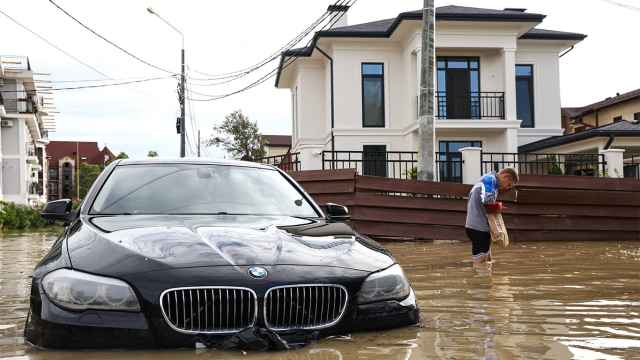
Flash Floods Trigger Evacuations on Russia’s Black Sea Coast

In Photos: Deep Freeze Descends on Siberia

Moscow Pummeled By Historic Snowfall

Russia Records Second Straight Year of Historic May Heat
Electrostal History and Art Museum

Most Recent: Reviews ordered by most recent publish date in descending order.
Detailed Reviews: Reviews ordered by recency and descriptiveness of user-identified themes such as wait time, length of visit, general tips, and location information.
Electrostal History and Art Museum - All You Need to Know BEFORE You Go (2024)
- (0.19 mi) Elektrostal Hotel
- (1.21 mi) Yakor Hotel
- (1.27 mi) Mini Hotel Banifatsiy
- (1.18 mi) Elemash
- (1.36 mi) Hotel Djaz
- (0.07 mi) Prima Bolshogo
- (0.13 mi) Makecoffee
- (0.25 mi) Amsterdam Moments
- (0.25 mi) Pechka
- (0.26 mi) Mazhor

COMMENTS
The most-recent incident was the sinking of a yacht on Oct. 31 in the Strait of Gibraltar. ... On June 19 an orca rammed a 7-ton yacht multiple times off the Shetland Islands in Scotland, ...
Three orcas (Orcinus orca), also known as killer whales, struck the yacht on the night of May 4 in the Strait of Gibraltar, off the coast of Spain, and pierced the rudder."There were two smaller ...
A pod of orcas has sunk a yacht in the Strait of Gibraltar. A pair of orcas swim off the west coast of Vancouver Island in 2018. For 45 minutes, the crew of the Grazie Mamma felt like they were ...
The most recent encounter occurred on May 4 off the coast of Spain. Three orcas struck the rudder and side of a sailing yacht, causing it to eventually sink, as was reported earlier this month in ...
Orcas Sank 3 Boats in Southern Europe in the Last Year, Scientists Say. A small group of orcas is ramming into sailboats in waters off the Iberian Peninsula. Researchers say they do not know what ...
A trio of orcas attacked a boat in the Strait of Gibraltar earlier this month, damaging it so badly that it sank soon afterward. The May 4 incident was the third time killer whales (Orcinus orca ...
Orcas caused enough damage to sink a yacht in the Strait of Gibraltar last week. A small pod has been slamming boats in recent years, worrying skippers charting routes closer to shore.
Theory No. 2: The orcas want vengeance. Orcas off the Iberian Coast like to follow fishing vessels to snag bluefin tuna before fishermen can reel them in, putting the aquatic mammals at risk of ...
Scientists don't know why. An orca pod seen in the Strait of Gibraltar in 2021. Ester Kristine Storkson was asleep on her father's small yacht earlier this month, sailing off the coast of France ...
In June and November 2022, a pair of attacks caused two boats to sink; earlier this month, a badly damaged boat sank while it was being towed to shore. Why the attacks may have started
Killer whales are pictured during a storm in the fjord of Skjervoy in 2021 off the coast of northern Norway. Researchers say orcas are stepping up "attacks" on yachts along Europe's Iberian coast ...
May 21, 2023 at 7:46 a.m. EDT. An orca leaps out of the water near a whale-watching boat off Washington's San Juan Islands. (Elaine Thompson/AP) A spate of encounters between orcas and boats off ...
Orcas have been documented damaging or sinking boats off the coast of Spain and Portugal, but these altercations may simply be the whales scratching their backs on boats or playing terrifying games
Orcas have been bumping boats in multiple Strait of Gibraltar incidents since 2020. This orca yacht attack is the latest in a spate of killer whales sinking boats. Accessibility statement Skip to ...
On May 5, the 50-foot sailing yacht Alboran Champagne sank after being struck by orcas the previous night — the third vessel in the last three years to go under after a run-in with some unruly ...
In Telegram chats, they ask for feedback on detours to avoid what has been called "orca alley.". "People are more informed," said Rui Alves, a former sailor who founded Orcas.pt to help ...
Nov. 9, 2023, 5:23 AM PST. By Patrick Smith. A yacht sank after it was attacked by a pod of orcas for 45 minutes, a sailing company has said, marking the latest assault on a boat by the sea ...
This orca attack was unexpected, the tourist company says. ... Orcas in the water, orcas attacking boats, sinking them off coast of Europe ...
Find company research, competitor information, contact details & financial data for BETA GIDA, OOO of Elektrostal, Moscow region. Get the latest business insights from Dun & Bradstreet.
Norilsk was built in Stalin's times by gulag prisoners. This gritty industrial city is a testament to their endurance both of the cruelty of Stalin's regime and of the harsh polar climate.
Residents of a Moscow region town impacted by power outages have taken to the streets, demanding that local authorities restore heat to their homes as subzero temperatures grip the region, Russian ...
Mission Inn Museum Bukit Ampang Lester Park Mount Huashan Ostional National Wildlife Refuge Wiener Stadthalle Long Island Rail Road Animate Ikebukuro Flagship Store Boston Water Taxi Torrox Market Patom organic village farm Thai cultural work shop Floating market tour bangkok Victoria to Seattle High-Speed Passenger Ferry: ONE-WAY Whale Watching in Kaikoura by Boat 2 hours Boat Rental Lake ...